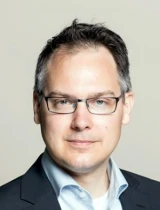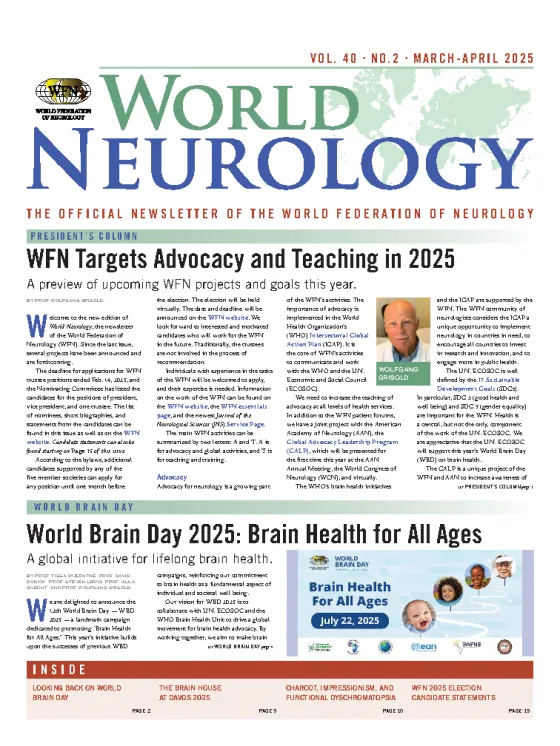Document Download: World Neurology - March-April 2025

Description:
World Neurology: March-April 2025, Volume 40, No. 2
Released: 26 Apr 2025
Published: 20 Aug 2025
Published by Ascend Integrated Media LLC, Kansas, USA
From the editors
Steven L. Lewis, MD, Editor, and Walter Struhal, MD, Co-Editor



Educational Opportunities, World Congresses, and Outreach
We'd like to welcome all readers worldwide to the April 2025 issue of World Neurology.
In this issue's President's Column, WFN President Prof. Wolfgang Grisold updates readers on the many evolving World Federation of Neurology (WFN) activities, including the upcoming WFN elections and critical initiatives related to advocacy, education, and publications. He also highlights the upcoming World Brain Day 2025 and the exciting plans for the World Congress of Neurology 2025 coming up in October in Seoul, South Korea.
This issue includes two reports on World Brain Day. First, Dr. Tissa Wijeratne, co-chair of World Brain Day 2025, provides a brief historical overview of the development and evolution of the themes and activities of World Brain Day over the past decade. In an accompanying report, Dr. Wijeratne and David Dodick, World Brain Day co-chair, along with Dr. Steven Lewis, Dr. Alla Guekht, and Prof. Grisold, provide an update on the theme of World Brain Day 2025, "Brain Health for All Ages," and the many activities being planned to support and enhance this global initiative.
Dr. Stefan Meng from Vienna, Austria, reports on the most recent 2-day course on nerve ultrasound. The annual event has taken place at National Taiwan University in Taipei since 2016. This issue also includes two reports on the launch of the Brain House at Davos, Switzerland. This year, it was held in conjunction with the World Economic Forum and hosted by the Davos Alzheimer's Collaborative. In the first report, Dr. Morris Freedman, WFN treasurer, provides the official WFN report from the event, which served as a global platform to highlight the link between brain health and economic growth. In the next report, Prof. Alfred K. Njamnshi and his esteemed coauthors provide further details of this seminal multidisciplinary event highlighting the importance of brain health in productivity, resilience, and well-being.
In this issue's History Column, titled "Charcot, Impressionism, and Functional Dyschromatopsia," Dr. Peter Koehler provides his insights into an association between the artistic school of Impressionism and the Salpêtrière. This issue includes the statements for candidates who were put forward by the WFN Nominating Committee for the positions of WFN president, first vice president, and elected trustee. You can find more about the WFN election process on our website. Editorial oversight of the candidate's statements for this section of World Neurology was taken over by WFN President Wolfgang Grisold to avoid any potential conflict of interest by the editors of World Neurology.
We also would like to draw your attention to "Neurology in the 21st Century," which provides an overview of neurology in the current century. It was published in the March 22, 2025, issue of Annals of Neurology. It was written by Dr. John England, editor-in-chief of the Journal of the Neurological Sciences, WFN's official journal, with collaborators Drs. Ann C. Tilton and Carlayne E. Jackson, immediate past-president of the AAN.1 We think World Neurology readers will find this contemporary thought piece of interest. In closing, thanks to all neurologists and neurologic trainee readers in all regions of the world for your interest in the WFN and in World Neurology. We look forward to your contributions to this publication and any suggestions for improvement. ■
Highlights
President's Column
-
WFN Targets Advocacy and Teaching in 2025 ⧉
By Wolfgang GrisoldWelcome to the new edition of World Neurology, the newsletter of the World Federation of Neurology (WFN). Since the last issue, several projects have been announced and are forthcoming. The deadline for applications for WFN trustee positions ended Feb. 14, 2025, and the Nominating Committee has listed the candidates for the positions of president, vice president, and one trustee. The list of nominees, short biographies, and statements from the candidates can be found in this issue as well as on the WFN website. According to the bylaws, additional candidates supported by any of the five member societies can apply for any position until one month before the election. The election will be held virtually. The date and deadline will be announced on the WFN website. We look forward to interested and motivated candidates who will work for the WFN in the future. Traditionally, the trustees are not involved in the process of recommendation.
World Brain Day
- World Brain Day 2025: Brain Health for All Ages ⧉
By By Prof. Tissa Wijeratne, Prof. David Dodick, Prof. Steven Lewis, Prof. Alla Guekht, and Prof. Wolfgang GrisoldSince its launch in 2014, World Brain Day has been a flagship initiative of the WFN, organized in collaboration with leading international societies such as the International League Against Epilepsy, World Stroke Organization, International Headache Society, World Federation of Neurorehabilitation, and Movement Disorders Society. Each year, a crucial theme is chosen to emphasize the importance of brain health and drive positive action.
From The Editors
- Looking Back on World Brain Day ⧉
By Prof. Tissa WijeratneThe World Brain Day (WBD) campaigns from 2014 to 2025 have played a transformative role in advancing global awareness, advocacy, and action for brain health. Over the past decade, WBD has evolved into a powerful platform for raising awareness, influencing policies, and promoting best practices for neurological care and prevention. Each year, the campaign has focused on a key theme, driving international collaboration among health care professionals, policymakers, and the public.
Around the World
- The Brain House at Davos 2025 ⧉
By Morris FreedmanThe launch of the Brain House was held in conjunction with the World Economic Forum in January 2025 in Davos, Switzerland. It was hosted by the Davos Alzheimer's Collaborative (DAC) under the leadership of George Vradenburg, chair of the DAC and founder of Brain House. Co-organized by Harris Eyre, who leads the Baker Institute Neuro-Policy Program at Rice University, Brain House served as a global platform to highlight the critical link between brain health and economic growth. I attended on behalf of the World Federation of Neurology (WFN) as a trustee and treasurer.
- Nerve Ultrasound Training ⧉
By Stefan Meng, MDEach year, a two-day course on nerve ultrasound takes place in Taipei. Founded and organized in 2016 by Prof. Ke-Vin Chang from the National Taiwan University, the course focuses on standards in nerve ultrasound. All main nerves, including median nerve, ulnar nerve, and sciatic nerve, are discussed with ultrasound anatomy. This includes common pathologies and ultrasound-guided interventions, using a landmark-based approach to locate the nerve with ultrasound.
- Brain Health Is Brain Wealth ⧉
By Alfred K. Njamnshi, Harris A. Eyre, Zul Merali, Frédéric Destrebecq, Kristina Adorjan, and Claudio L. A. BassettiSince the inaugural World Brain Day (WBD) on July 22, 2014, the World Federation of Neurology (WFN) has been celebrating the brain each year to raise global awareness about its vital importance.The celebration of WBD has been expanded in some parts of the world to a full week of activities focused on the brain. Brain Week in Cameroon and Africa (BWCA) by the Society of Cameroonian Neurologists (SCAN) and Brain Research Africa Initiative (BRAIN) is one example.
History
- Charcot, Impressionism, and Functional Dyschromatopsia ⧉
By Peter J. KoehlerThis year, attention to the bicentennial of the birth of one of the founders of neurology, Jean-Martin Charcot (1825-1893, see Figure 1) will be given in several places. There will be a special issue of the Journal of the History of the Neurosciences, covering topics around Charcot that have so far gone unmentioned. Many aspects of Charcot's career and his interest in art have been described in the past or will be discussed in the special issue.
Candidate Statements
Seven candidates have been recommended by WFN's Nomination Committee for the upcoming election of president, first vice president, and elected trustee to take place by electronic voting in September.
- Candidate Statement for President: Prof. Steven Lewis ⧉
- Candidate Statement for President: Dame Pamela Shaw ⧉
- Candidate Statement for First Vice President: Prof. Riadh Gouider ⧉
- Candidate Statement for First Vice President: Tissa Wijeratne ⧉
- Candidate Statement for WFN Elected Trustee: Chandrashekhar Meshram ⧉
- Candidate Statement for WFN Elected Trustee: Ghazaleh Tabatabai ⧉
- Candidate Statement for WFN Elected Trustee: Mayela Rodriguez-Violante ⧉







